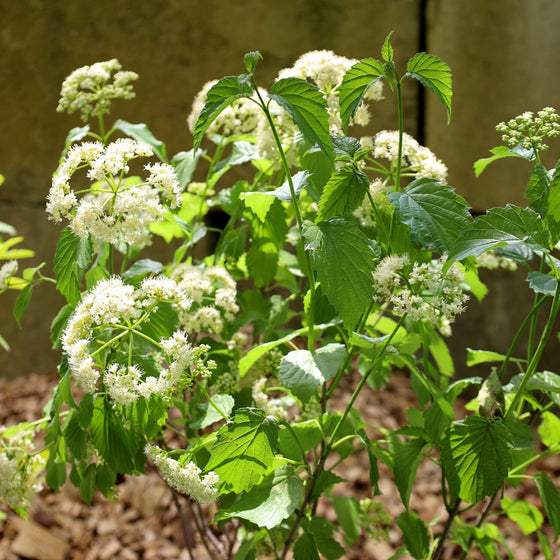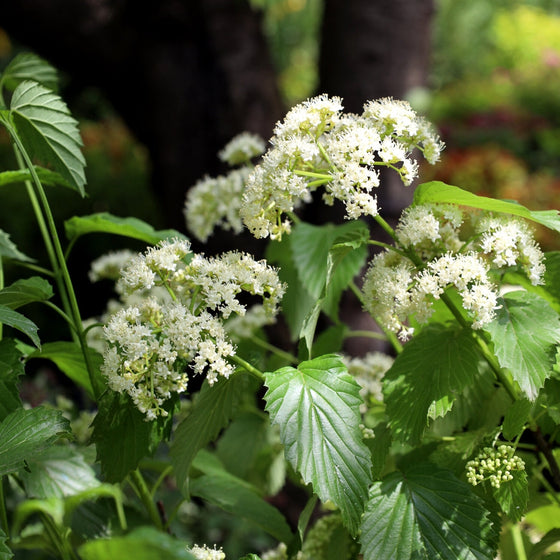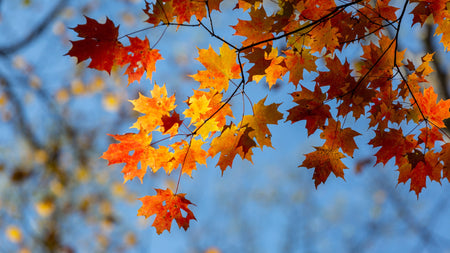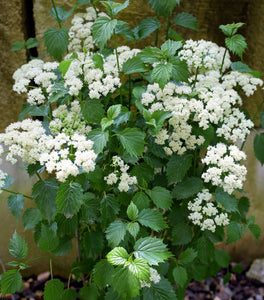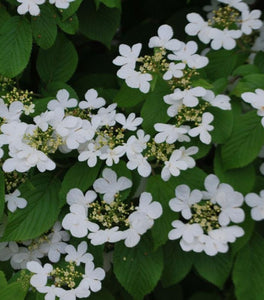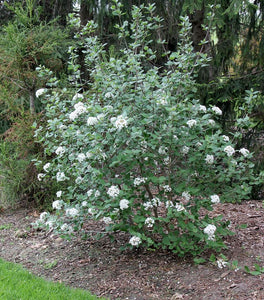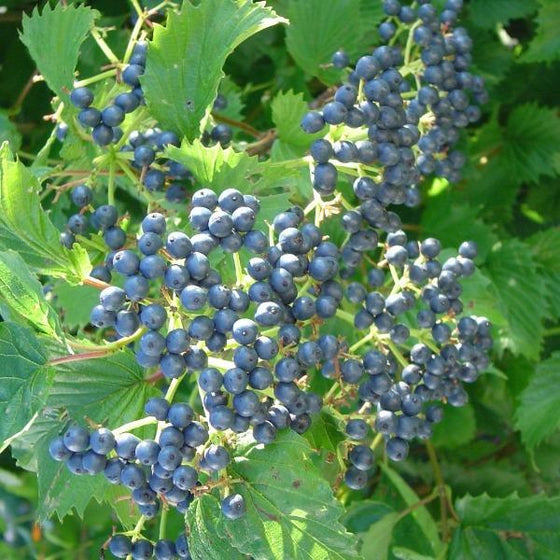
Images Depict Mature Plants
Arrowood Viburnum for Sale Online
Arrowwood Viburnum (Viburnum dentatum) is a versatile, deciduous shrub known for its multi-season interest and adaptability. Thriving in USDA Hardiness Zones 3-8, this hardy native shrub can reach a mature height of 6-10 feet and a spread of 6-8 feet, making it an excellent choice for hedges, privacy screens, or as a naturalized border in your landscape. In late spring to early summer, Arrowwood Viburnum produces clusters of creamy-white flowers that attract pollinators, including bees and butterflies, adding ecological value to your garden.
In addition to its beautiful blooms, Arrowwood Viburnum produces attractive blue-black berries in late summer and fall, which serve as a valuable food source for birds and other wildlife. Its glossy green leaves turn vibrant shades of yellow, orange, and red in the fall, providing striking seasonal color. This shrub is known for its durability, thriving in a wide range of soil types and tolerating both full sun and partial shade, making it an adaptable option for various garden conditions.
Low-maintenance and deer-resistant, Arrowwood Viburnum is an ideal choice for gardeners looking for a resilient, wildlife-friendly shrub. Once established, it is drought-tolerant and can handle different moisture levels, from dry soils to moist areas. Whether used as a focal point in a native garden or as part of a mixed border, Arrowwood Viburnum brings beauty and biodiversity to your landscape, offering year-round interest with minimal care required.
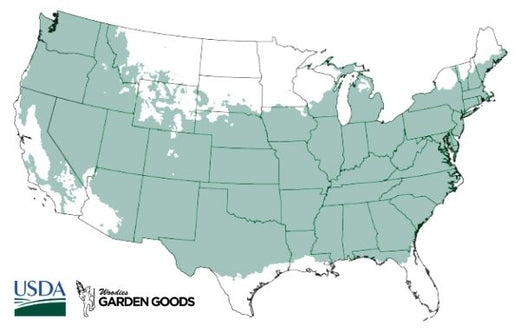
| Hardiness Zone: | 3-8 |
|---|---|
| Mature Height: | 6 to 10 feet |
| Mature Width: | 6 to 8 feet |
| Classification: | Broad leaved semi-evergreen shrub, spring flowering |
| Sunlight: | Full sun to partial shade |
| Habit: | Upright, densely branched |
| Foliage: | Dark green |
| Flower Color: | Creamy white |
| Pruning Season: | Prune in summer after flowering |
| Soil Condition: | Any well drained soil |
| Water Requirements: | Water well until established |
| Uses: | Pollinator for Blue Muffin Viburnum |
How to Care for Arrowwood Viburnum
Be sure to read our planting instructions to ensure a healthy and happy Arrowwood Viburnum for years to come!
How Do I Plant Arrowwood Viburnum?
To plant Arrowwood Viburnum, start by choosing a location with well-drained soil and either full sun or partial shade, as this shrub thrives in a variety of light conditions. Dig a hole that is twice as wide and as deep as the root ball to give the roots plenty of room to establish. Place the shrub in the hole so that the top of the root ball is level with the surrounding soil, then backfill with soil and gently firm it around the roots to eliminate air pockets. After planting, water thoroughly to help the plant settle in and establish its root system. Space multiple Arrowwood Viburnum shrubs 6-10 feet apart if you’re creating a hedge or privacy screen, ensuring room for them to grow to their mature size. Mulching around the base of the Arrowwood Viburnum will help retain moisture, suppress weeds, and regulate soil temperature, particularly during the first growing season. Water regularly, keeping the soil consistently moist but not waterlogged, especially during the shrub's establishment phase. Once the plant is established, it becomes more drought-tolerant and requires less frequent watering. In early spring, consider applying a slow-release, balanced fertilizer to encourage healthy growth and abundant blooms. With proper planting and care, Arrowwood Viburnum will thrive and provide year-round interest with its white flowers, blue-black berries, and stunning fall foliage.
How Do I Water Arrowwood Viburnum?
To water Arrowwood Viburnum, keep the soil consistently moist, especially during the first growing season to help establish a strong root system. Water deeply once or twice a week, ensuring that the water penetrates the soil and reaches the root zone. Deep watering encourages the roots to grow downward, promoting a more resilient plant. If you’ve recently planted the shrub or are experiencing dry weather, check the soil frequently and water as needed to maintain moisture. Mulching around the base of the plant can help retain moisture, reduce evaporation, and prevent weeds from competing for water. Once established, Arrowwood Viburnum becomes more drought-tolerant and requires less frequent watering. Typically, natural rainfall will be sufficient, but during extended periods of heat or drought, supplemental watering is necessary to keep the plant healthy and encourage its vibrant blooms and fruit production. When watering, avoid getting the foliage wet, as this can promote fungal diseases. By maintaining a consistent watering routine, especially during dry spells, your Arrowwood Viburnum will thrive and reward you with beautiful white flowers in spring and blue-black berries that attract birds in the fall.
How Do I Fertilize Arrowwood Viburnum?
To fertilize Arrowwood Viburnum, apply a balanced, slow-release fertilizer in early spring, just as new growth begins. A general-purpose 10-10-10 or 14-14-14 fertilizer works well, providing essential nutrients like nitrogen, phosphorus, and potassium to promote healthy leaf growth, strong roots, and abundant flowering. Spread the fertilizer evenly around the base of the shrub, avoiding direct contact with the trunk. After fertilizing, water the area thoroughly to help the nutrients absorb into the soil and reach the root zone. Fertilizing once a year in the spring is typically sufficient for Arrowwood Viburnum to thrive throughout the growing season. For an organic approach, top-dressing the soil with compost or well-rotted manure in the early spring can also be effective. This method improves soil structure while slowly releasing nutrients over time. Avoid over-fertilizing, as too much nitrogen can lead to excessive foliage growth at the expense of blooms and berries. Proper fertilization helps Arrowwood Viburnum maintain its vibrant green foliage, produce plentiful white flowers in spring, and develop the blue-black berries that attract birds and wildlife in the fall, ensuring your shrub remains healthy and visually striking year-round.

How Do I Prune Arrowwood Viburnum?
To prune Arrowwood Viburnum, the best time is immediately after it finishes blooming in late spring or early summer. Since Arrowwood Viburnum blooms on old wood, pruning after flowering ensures you won’t remove the buds for next year’s flowers. Start by removing any dead, damaged, or diseased branches to improve the plant’s health and appearance. Use sharp, clean pruning shears to make cuts just above a healthy bud or at the base of a branch. You can also lightly shape the shrub to maintain its natural form without cutting too much, as heavy pruning can reduce flowering and berry production. If your Arrowwood Viburnum becomes too dense, you can thin it out by cutting back some of the older, inner branches to improve air circulation and light penetration, which promotes better flowering. Avoid cutting more than a third of the plant at one time to prevent stress. Regular light pruning encourages more blooms and keeps the shrub looking neat and tidy while preserving its natural, attractive shape. By following proper pruning techniques, you’ll enhance the Arrowwood Viburnum’s ability to produce its signature white flowers and blue-black berries, providing multi-season interest and wildlife benefits in your garden.

